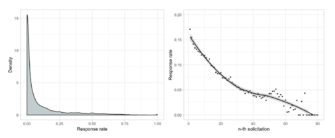Substitute Donor For Panelist
Online survey research companies build panels of millions of consumers willing to participate in periodic survey research. They are paid to do so but research shows they also do so out of goodwill.
These panel companies are analogous to charities with major acquisition costs and retention issues galore. Plus, these panel companies use email solicitations to invite panelists to participate.
There is a paper entitled “Silently killing your panelists one email at a time: The true cost of email solicitations”.
The key findings and my commentary follow, substitute “donor” for “panelist”.
The costs of sending an email are largely fixed with the variable cost close to zero. If they’re free to send, why not email everyone every day or every hour or minute?
An online panel manager said “sending too many messages will kill the panel”. So, there is a heuristic of sorts, we seem to know every minute is too much but once a year is too few.
Some panelists will simply stop responding over time but how much of this is caused by the irritation of frequent email solicitations?

These curves should look familiar,
- The left chart shows most people don’t respond very often but a small few respond a lot (relatively speaking) – the long tail
- The right chart shows response rate going down as solicitation volume goes up. This is human behavior 101 stuff – you are not creating many new dollars with solicitation, merely shifting them forward.
The more wonky analysis answered the causal question and found:
- Increasing waiting time of email solicitation when the panelist is new hurts response.
- However, increasing the waiting time after the first few increases response and retention.
- Taking together, frequent solicitation often increases short term panelist response but “kills” them faster.
- They estimated each email solicitation “killed” 1/16th of its panel. The 6% is an individual estimate so it varies widely, from between 2% and 24% dropout rate for each person.
- Past response does predict future response but much more so at lower baselines.
- Panelists most likely to respond are also more likely to silently churn.
This all comports. Not sending an email to someone who just signed up to your email list is a miss. The expectation is there and the memory of signing up fades fast. But, bury me in email and I tune out.
And I’m sure the 6% figure feels high but remember, the vast majority of your email subscriber list just silently dies, they don’t unsubscribe or take any action, other than inaction.
It is possible your email solicitation is turning your best donors into your worst. These people are more attuned to each email given higher preliminary interest and therefore, more likely to see and feel the volume.
Kevin


